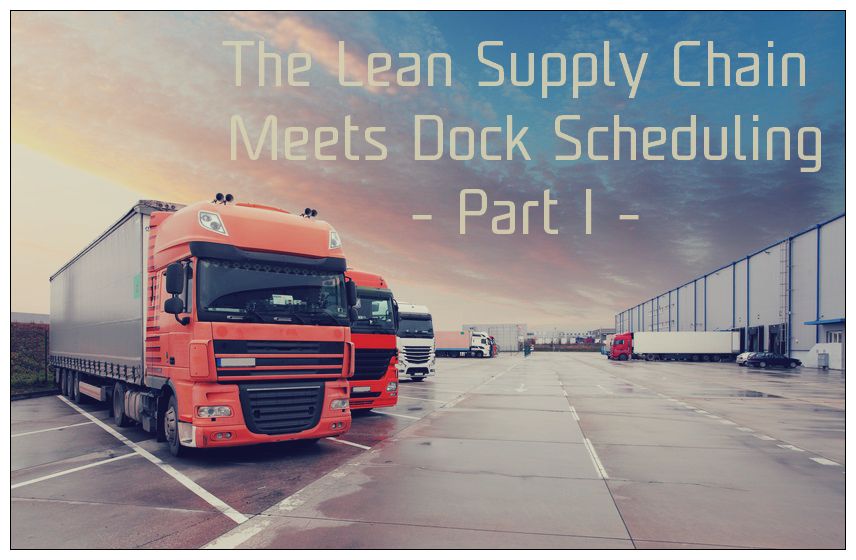The Lean Supply Chain meets Dock Scheduling - Part I

After reading an interesting article about the Lean Supply Chain that encourages businesses to consider purchasing collaborative and automation software when conducting Lean techniques, I immediately thought readers might appreciate some practical examples of this.
To summarize the article , the author points out that applying Lean (I would add any continuous improvement initiatives) today requires that companies consider collaborative and automation technologies in order to get the most out of the improved process. He identified the key benefits as including:
-
Added competitive advantage
-
Increased visibility
-
Increased efficiency
-
Better customer relationships
-
Improved responsiveness
-
Better decision making
-
Optimization of supply chain operations
We have seen evidence of this in both dock scheduling and yard management. In this first blog, we’ll provide practical examples of how a dock scheduling system can provide a competitive advantage, increased visibility and efficiency. The four latter points will be covered in a second blog post.
Added competitive advantage
It would be too simple to say that automated systems reduce costs and therefore improve the competitive advantage. It’s much more than this.
Take for example the case of a multi-tenant third-party warehouse. They are particularly sensitive about driver wait times, overall turnaround times and the timing of their load schedule. One can say that being very efficient is a competitive advantage in their industry.
A client explained how they publish the reports regarding the driver wait times (near zero) and quick turnaround times and give them to their salespeople. In turn, they’re using the reports as sales tools to demonstrate their competitive advantage regarding their customer service levels, including quick driver turnaround times.
Increased visibility
In the realm of dock scheduling, desired visibility is typically knowing when drivers are expected at your docks, what volumes (pallets, units, weight) they’ll deliver/pick-up, and the load types (floor loaded, palletized, containers), etc.
A practical example that comes to mind is one most often seen in the retail and distribution industries. We hear warehouse managers complain that their purchasing departments place orders with little consideration for their warehouse capacity. In fact, the buyers simply don’t have the visibility on warehouse capacity.
After implementing the dock scheduling system and integrating PO data from their ERP/WMS, the warehouse managers can now see the volumes that are expected to be delivered in the coming days and either adjust their capacity (e.g., labor) or advise the buyers ahead of time to correct the incoming volumes.
Improved visibility eliminated the element of surprise, reducing the risk of cluttering the floor with overflow stock and more importantly improved warehouse productivity by reducing overtime labor.
Increased efficiency
This sounds obvious since the entire principal behind Lean techniques and continuous improvement initiatives is to achieve this. In the real world it is easier said than done.
The example that comes to mind is that of a reputable grocer (with project management and continuous improvement teams on board ensuring their processes are very efficient) who believed they already had a lean and efficient process before implementing a dock scheduling system.
The warehouse manager even stated that he didn’t believe putting a system in place would reduce the driver wait times and the inherent chaos that grocers often mistakenly accept as being ‘’part of doing business’’.
Despite the best processes and intentions, the traditional pen and paper approach to scheduling didn’t provide the maximum efficiency due to the multiple variables in play (load types, vehicle types, load priorities, etc.) and the high volume of communications (emails and phone calls) between the schedulers, carriers, vendors and internal users such as buyers, planners and stores.
The automated planning and scheduling features of C3 Reservations and the collaborative nature of the SaaS platform took their existing processes to another level and resolved the existing issues; increasing the efficiencies in the flow of trucks in and out of their warehouse and resulting in eliminating driver wait times and facilitating the reporting of their KPIs.
The doubting warehouse manager was convinced, just as the entire organization - the old pen, paper and spreadsheet tools were things of the past.
Conclusion
If you wish to read more practical examples of how a dock scheduling system can improve your processes, including; a) better customer relationships, b) improved responsiveness, c) better decision making, and d) optimizing supply chain operations, then we invite you to read part 2 of this blog.
